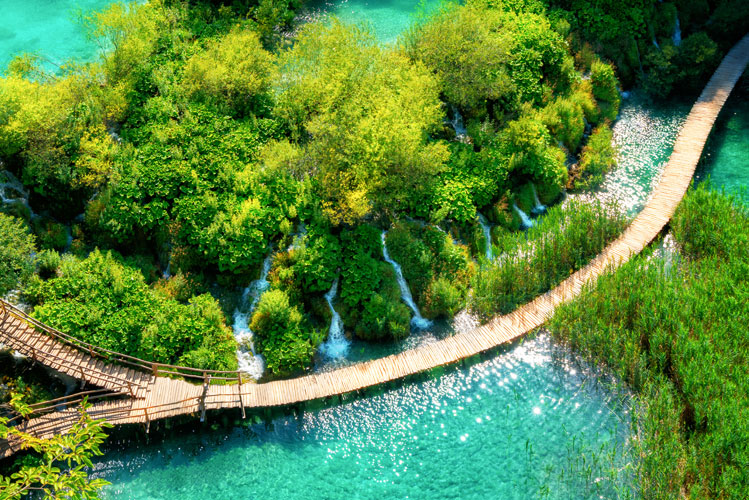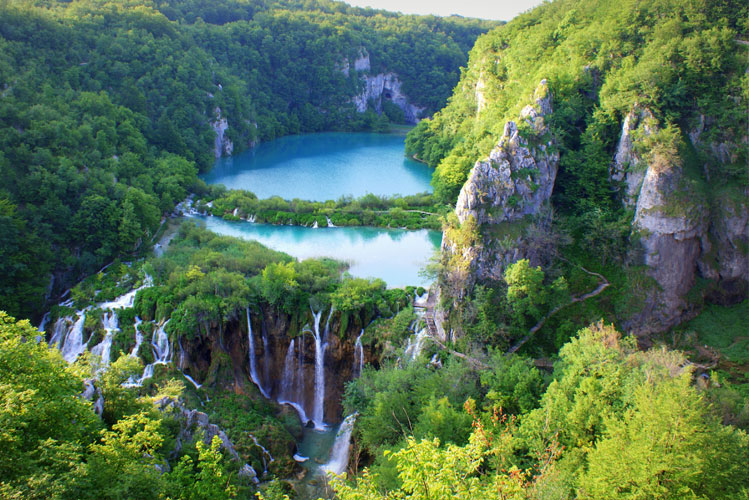Your Ultimate Itinerary To The Amazing Kornati National Park
by Welcome Center Croatia | Last updated Feb 21, 2022 | Published on Feb 30, 2022
Does the idea of island hopping during a hot summer vacation with the peace of untouched natural splendour excite you? If that is the case, Kornati national park is the perfect summer destination for you. It is an island archipelago with a whooping 89unihabited islands, reefs and islets, and it is most famous for its high cliffs. With only a handful of year-round residents, it offers a rugged landscape with natural sparkling waters, and it has charmed tourists yearning for the remote desert island feel.
Needless to say, Croatia has plenty of natural beauty to explore, most of which is evident in its stunning national parks. Although your best park, of course, depends on the summer activities you look forward to doing, Kornati island Croatia offers everything from archaeological sites to stunning beaches that will leave you craving for more. Touring the 89islands belonging to Kornati national park is now easier than ever, thanks to Croatia's growing popularity.
Discovering the Kornati national park
One of the fascinating things about Kornati national park is that it is entirely picturesque. If you love capturing memories, you can take a tour via a boat to take in the natural scenery, make stops by the shores and even hike on the hills to break the monotony of the tour.
The best part is when you get to the national park: there are plenty of activities to indulge from swimming to water sports like snorkelling, to make the best memories in one of Kornati's islands. The photogenic scenery of Kornati national park makes it stand out from the rest of Croatia's national parks.
That said, here is your ultimate guide to discovering the Kornati national park and its splendour.
Location of Kornati
The Kornati national park sits in the dense Kornati archipelago with 149islands, islets and reefs. Trailing the coast between Zadar and Sibenik, this famous stretch of islands, islets and reefs is divided into two: Gornji Kornati, the upper half and Dornji Kornati, the lower half, which includes the largest island of Kornat from which the archipelago derives its name.
Instead of the monotonous majestic castles and walls everyone is used to, you will be in the midst of an uninhabited stretch of land and admire the civilisation that once thrived there. If you love underwater activities, the Adriatic sea offers diving and snorkelling opportunities to create the adventure of a lifetime.
The islands make an interesting place because some of them are beautiful uninhabited places with a karstic terrain full of natural caves, caverns and cliffs that have formed over the ages. Most of them are desolate due to the absence of freshwater sources. Others host a stretch of vineyards, orchards and olive groves that attract seasonal farmers to attend to them.
Interestingly, the long stretch of the Kornat Island creates a protected water body for boats to peacefully sail in and cut through the narrow channels between the islands without the nuisance of heavy waves. The Adriatic marine life hosts rare corals, algae and molluscs that offer an unrivalled swimming and snorkelling adventure.
Out of the 149 islands, 89 have a national park status and are protected, making for safe adventures. Keep in mind that most of the Kornati national park terrain features rock formations and a clear blue sea, so do not expect many glamorous spots to hang out.
How to get to the Kornati national park
By boat
Like any other archipelago, you can only get to the Kornati islands by boats, usually departing from Murter, a small town. Since Kornati island is a famous destination for nautical tourists, you will find one ACI marina within the Kornati national park; ACI Piskera on Piskera island. There is also another marina outside the national park, ACI Zut on Zut island.
Luckily, you can also tag along to one organised boat tour from Zadar, Murter or Sibenik. These tours are plenty in the high season (July and August), accommodating private groups and lone travellers.
Organised tours come with perks such as a boat ride, tourist guide, welcome drinks, lunch and a Kornat national park entrance ticket. Although there are no official marinas on Kornat island, there are plenty of spots to dock, and most places of interest have buoys for their guests.
By car or bus
A convenient way to get to Murter is by bus. There are direct line buses that connect to various Croatian cities. Zagreb and Biograd na Moru are the coastal towns closest to the Kornati hence the most logical direct bus lines for most travellers coming to the Kornati from the mainland.
You can find day excursions to the Kornati national park in other towns like Zadar, Primosten, Sibenik, Kukuljuca, Trogir, Pirovac, Pakostane, and Vodice. Since most Kornati islands are uninhabited, you must leave enough time for a return trip.
By plane
If you prefer to land in the Kornati national park, you can use either Zadar airport or Split airport. Although Split is still close enough to connect to the park, Zadar airport is the closest and most convenient.
Entrance to the Kornati national park and fees
You need a valid entrance ticket for every day of your stay in the Kornati national park. The amount of entrance fees you pay depend on how you access the park. For instance, you must pay a sail-in ticket if you have a private boat. Thankfully, some organised day tours already include the entrance fee to the park.
The entrance fee may not include charges to go diving, but snorkelling is free of charge. Purchasing tickets from the park's webshop and even outside its premises is cheaper than purchasing them from a receptionist within the park. Note that the entrance fee is almost twice as expensive at the park than at agencies.
What you need to know about the Kornati
It has plenty of rich history
The ruins of the Illiryian forts found in different Kornat locations are proof of the history of colonisation of the Kornati, which took place during the Illyrian period. You will get to see and enter some Roman ruins in the Kornati, including distinct Roman villas.
The Byzantine period left traces in the Tureta fortress on the Kornat island, believed to have been built in the 6th century AD. History says it was used as a watch fort, which explains why it is inaccessible and still in good condition. That means no people were interested in taking down the stones to build their own houses near the area.
In low tide hours, you will see the remains of saltworks from the 14th century on the Lavasa island, although it is almost entirely submerged these days due to the gradual rise of the sea surface.
Things To See And Do At Kornati National Park
Discover Vela Ploča or Magazinova Škrila on the island of Kornat
You will discover a rare kind of geology in the form of a large (the size of two football pitches) limestone plate near the highest peak of Kornat island. At a closer eye, the salt appears to have slipped off from the limestone plate leaving behind a magical view of a white mirror-like surface.
A native folktale says that the fairies created the magical surface so that they could dance there. The tale might be another myth, but you need to visit the vela place and see for yourself; you never know when the fairies will show up to dance.
Must see handbuilt crosses on the Kornati island
One of the notable peacetime disasters in modern Croatian history happened on the island of Kornat. On 30th August 2007, a fire broke out there, and a group of 13 firefighters were sent to put it out. Twelve of them lost their lives in the fire, while the remaining survivor suffered severe injuries. The circumstances that led to the loss of the 12lives are still unknown.
If you happen to go hiking in the Kornati islands and come across the 12 crosses, please pay your respects. A Croatian architect called Nikola Basic came up with the memorial, and the unique thing about the crosses is that they were handbuilt in the old drywall technique.
Dry stone walls
Drywall stones Please do not leave the Kornati archipelago without allowing yourself the pleasure of exploring the splendour and beauty of the islands. One of the amazing facts is how human beings have interacted with the rugged nature of the islands. Dry stone walls prove that the local inhabitants reared sheep on the islands thousands of years ago.
Although they look bare without any trees, long grasses that sheep enjoy grow there. According to history, every owner would confine sheep in their property to prevent mixing. The drywall stones stretch from one coast to the other in a parallel pattern that is quite unmatched.
High cliffs
As earlier mentioned, the Kornati archipelago is famous for its high cliffs. Amazing photos of a high cliff diving into a sea influence many tourists to visit the location. Thanks to the waves, the sides of the islands overlooking the open sea are sculpted, but they are also proof of the seismic activity of the area whereby the archipelago protruded when the two tectonic plates crashed.
On Klobucar island stands the highest crown (82meters above sea level) in the whole archipelago, and on the mana island is the longest cliff where an outstanding wall of 1350meters covers the total coastline. As you stroll around, look out for several birds that perch on the cliffs, such as peregrine falcons flying around. Do not contemplate climbing or jumping off the cliffs, as such activities are prohibited.
Church of our lady Tarac
Church of our lady Tarac is one of the ancient buildings from the middle ages that carry the cultural history of Kornati national park. It is a modest one nave structure built in the 17th century, and its unique design is quite breathtaking. According to history, it was constructed from the remnants of the basilica that stood near it. It is dedicated to the remembrance of Mary.
If you are a religious person, you can attend the masses held there on the first Sunday of every July. Even though the surrounding area is desolate, traces of buildings suggest that there used to be a community living there.
Fortress Tureta
The Kornati island also features majestic defensive structures dating back to ancient times. The Fortress Tureta is one of the remarkable structures that stood in the byzantine times. It was constructed for military and navigation purposes as the militants used it to control the lands and marine traffic in the Adriatic sea.
It takes a 10minute climb from the foot of the hill to get to the fortress. You will be happy to be on a spot that gives you a view of the land and sea below.
Sailing
The Kornati islands are the ideal sailing destination with a mix of breathtaking views from the sea and excellent food in the restaurants to enjoy. As a visitor, you can discover great places to moor and dock for other water activities like swimming and snorkelling. The best way to take in the view of the Kornati archipelago is to sail around, and you can bet it will be your best experience in Croatia.
Diving
Thanks to the archipelago's crystal clear waters that allow light to penetrate deep in the seas, the Kornati islands are perfect for diving activities. There is also so much marine life to see underwater, including corals and colourful fish. Better yet, you don't have to share your swimming or diving spot with more than a handful of people because of the secluded nature of the archipelago.
You cannot dive on your own in the park, and you also need a permit accompanied by a licensed diving group. Kornati Diving, Diving Safari, Najdi Laguna, Rc Tramonto are some of the recognised diving organisations that adhere to Croatian diving guidelines.
Hiking
The epic views of the Kornati national park provide opportunities for hiking activities. The islands have a sparse terrain which means there are very few shelter spots, so it is best to start early in the morning and carry your sunhat, water, and sunscreen. Hiking allows you to take in the rugged terrain formed millions of years ago.
Special Events in the Kornati national park
You may plan your travel around specific times of the year to catch special events in the Kornati national park.
On the first Sunday of July, the people of Kornati hold a religious festivity. It is a catholic social holiday celebrating the feat of the madonna of Tarca. It is an exciting festival you might want to catch even if you are not big on religious matters.
The Kornati cup is another special event, a sporting activity of traditional sailboats, and it happens in April every year.
THE TAKEAWAY
Your experience in the Kornati national park depends on the kind of tour you take, but you can expect a perfect combination of land and sea activities. Thanks to its dramatic cliffs rising directly from the sea, you can capture incredible images of the photogenic archipelago and take advantage of the clear sparkling waters to discover what goes on under the water. Swimming and snorkelling are some of the must-do activities in the Kornati, especially since you don't need a special permit to do that.



